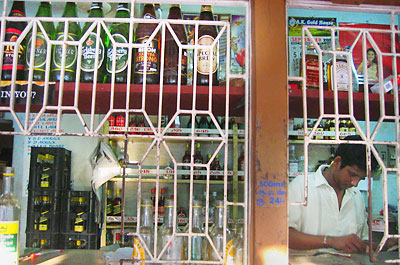
A liquor store.-Liza Lin
The Changing Face Of Alcoholism
LIZA LIN
KALMUNAI, SRI LANKA
EVERYDAY since Dec 26, Sager, 41, has felt the waves of the tsunami carrying him from his house out into the sea. Everyday, he remembers the faces of the two children he lost that fateful morning. If only, the tsunami had taken his life as well, the former fisherman thinks. But it hasn't, and he drowns his sorrows daily by downing half a bottle of arrack.
It is an expensive habit for the unemployed Sager, who spends 100 rupees a day on the liquor, but he hasn't tried to kick it.
"Some days I try to stop my drinking, but then I always remember my children, then I can't stop," says the gaunt man with beady bloodshot eyes.
For Sager, the tsunami did not just snatch the lives of two of his nine children. It carried away his fishing boat, destroying his livelihood as well. Without a boat, he has given up fishing, choosing to hang around the refugee camp where he stays at in Kalmunai town, Ampara, eastern Sri Lanka.
His wife, Analahumy, 39, has tried unsucessfully to stop her husband from drinking.
She shrugs her shoulders in resignation, saying, "Before the tsunami, he drank only at night, now, he drinks almost 24 hours."
Not an uncommon problem
Alcohol has always been a persistent problem - even before the tsunami killed more than 30,000 and displaced nearly 483,000 from their homes. Sri Lanka has one of the world's highest alcohol consumption rates and in 2003, the country of 19 million consumed a total of 134 million litres of alcohol in the form of arrack, beer, and toddy. Arrack is Sri Lanka's national liquor, made from fermented palm sap.
The Sri Lanka Society of Medicine also reveals that 30,000 persons die per year in Sri Lanka as a result of consuming liquor.
Still, alcohol consumption is on the rise. Many Sri Lankans have turned to drink to forget their worries in the eastern provinces of Ampara and Batticaloa - a region devastated by the catastrophe, where long term aid is trickling in and normalcy a distant possibility.
Licensed liquor store owner, V. Selvarajah, says, "Previously, the people who frequented my bar were men between the ages of 30-35, now I see more youngsters between the ages of 20-21 and women coming in."
Mr Selvarajah, who has run the store for more than 23 years, saw the sales at his store in Kalmunai improve by more than 10 per cent in the wake of the tsunami. In a good month, he says, he rakes in about 20,000 rupees more in revenue.
Reverend S. Selvantha, a Christian pastor who counsels the refugees at the Periyaneelavanai refugee camp, says, "If people only drank half a bottle before the tsunami, they are drinking one now."
next »